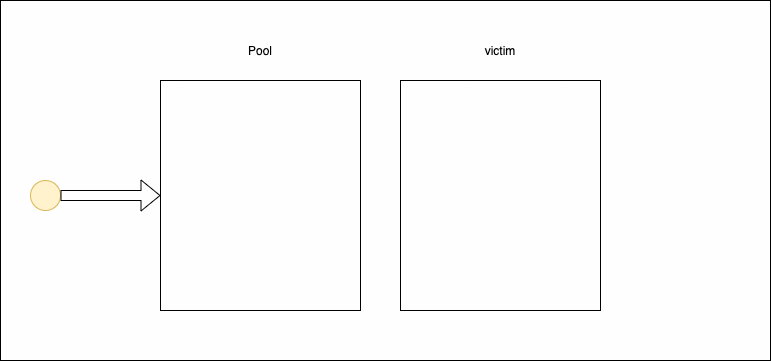原文:https://medium.com/swlh/go-the-idea-behind-sync-pool-32da5089df72
-----------------------
I encountered a problem in Go Garbage Collection inside a project of mine recently. A massive amount of object were allocated repeatedly and caused a huge workload of GC. Using sync.Pool I was able to decrease the allocations and GC workload.
What is sync.Pool?
One of the highlights of Go 1.3 release was sync Pool. It is a component under the sync package to create a self-managed temporary retrieval object pool.
Why to use sync.Pool?
We want to keep the GC overhead as little as possible. Frequent allocation and recycling of memory will cause a heavy burden to GC. sync.Pool can cache objects that are not used temporarily and use them directly (without reallocation) when they are needed next time. This can potentially reduce the GC workload and improve the performance.
How to use sync.Pool?
First you need to set the New function. This function will be used when there is no cached object in the Pool. After that you only need using Get and Put methods to retrieve and return objects. Also a Pool must not be copied after first use.
Due to New function type, which is func() interface{}, Get method returns an interface{}. So you need to do a type assertion in order to get the concrete object
// A dummy struct
type Person struct {
Name string
}
// Initializing pool
var personPool = sync.Pool{
// New optionally specifies a function to generate
// a value when Get would otherwise return nil.
New: func() interface{} { return new(Person) },
}
// Main function
func main() {
// Get hold of an instance
newPerson := personPool.Get().(*Person)
// Defer release function
// After that the same instance is
// reusable by another routine
defer personPool.Put(newPerson)
// Using the instance
newPerson.Name = "Jack"
}
sync.Pool example
Benchmark
type Person struct {
Age int
}
var personPool = sync.Pool{
New: func() interface{} { return new(Person) },
}
func BenchmarkWithoutPool(b *testing.B) {
var p *Person
b.ReportAllocs()
b.ResetTimer()
for i := 0; i < b.N; i++ {
for j := 0; j < 10000; j++ {
p = new(Person)
p.Age = 23
}
}
}
func BenchmarkWithPool(b *testing.B) {
var p *Person
b.ReportAllocs()
b.ResetTimer()
for i := 0; i < b.N; i++ {
for j := 0; j < 10000; j++ {
p = personPool.Get().(*Person)
p.Age = 23
personPool.Put(p)
}
}
}
Benchmark result:
BenchmarkWithoutPool
BenchmarkWithoutPool-8 160698 ns/op 80001 B/op 10000 allocs/op
BenchmarkWithPool
BenchmarkWithPool-8 191163 ns/op 0 B/op 0 allocs/op
Trade-off
Everything in life is a trade-off. The Pool has also its performance cost. It is much slower to use sync.Pool than simple initialization.
func BenchmarkPool(b *testing.B) {
var p sync.Pool
b.RunParallel(func(pb *testing.PB) {
for pb.Next() {
p.Put(1)
p.Get()
}
})
}
func BenchmarkAllocation(b *testing.B) {
b.RunParallel(func(pb *testing.PB) {
for pb.Next() {
i := 0
i = i
}
})
}
Benchmark result:
BenchmarkPool
BenchmarkPool-8 283395016 4.40 ns/op
BenchmarkAllocation
BenchmarkAllocation-8 1000000000 0.344 ns/op
How does sync.Pool work?
sync.Pool has two containers for objects: local pool (active) and victim cache (archived).
According to the sync/pool.go , package init function registers to the runtime as a method to clean the pools. This method will be triggered by the GC.
func init() {
runtime_registerPoolCleanup(poolCleanup)
}
When the GC is triggered, objects inside the victim cache will be collected and then objects inside the local pool will be moved to the victim cache.
func poolCleanup() {
// Drop victim caches from all pools.
for _, p := range oldPools {
p.victim = nil
p.victimSize = 0
}
// Move primary cache to victim cache.
for _, p := range allPools {
p.victim = p.local
p.victimSize = p.localSize
p.local = nil
p.localSize = 0
}
oldPools, allPools = allPools, nil
}
New objects are put in the local pool. Calling Put method will put the object into the local pool as well. Calling Get method will take an object from the victim cache in the first place and if the victim cache was empty the object will be taken from the local pool.

For your information, the Go 1.12 sync.Pool implementation uses a mutex based locking for thread-safe operations from multiple Goroutines. Go 1.13 introduces a doubly-linked list as a shared pool which removes the mutex lock and improves the shared access.
Conclusion
When there is an expensive object you have to create it frequently, it can be very beneficial to use sync.Pool.
For your information, the Go 1.12 sync.Pool implementation uses a mutex based locking for thread-safe operations from multiple Goroutines. Go 1.13 introduces a doubly-linked list as a shared pool which removes the mutex lock and improves the shared access.
Conclusion
When there is an expensive object you have to create it frequently, it can be very beneficial to use sync.Pool.